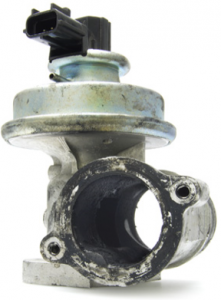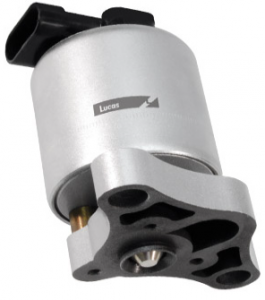The EGR valve reduces harmful nitrogen oxides (NOX) emissions from the exhaust.
NOX is produced when combustion temperatures exceed 2500°F and nitrogen begins to react with oxygen.
The EGR valve helps keep temperatures below the NOX threshold by recirculating a small amount of exhaust gas back through the combustion process, diluting the incoming air/fuel mixture.![]()
EGR valve failure
The most common cause of EGR valve failure is carbon deposits that cause clogging or sticking, leaving the valve may stuck open or closed.
 If the EGR is stuck in the open position, a continuous flow of exhaust gases will be sent back to the inlet manifold resulting in a rough idle when the engine is cold and stalling when the engine idles.
If the EGR is stuck in the open position, a continuous flow of exhaust gases will be sent back to the inlet manifold resulting in a rough idle when the engine is cold and stalling when the engine idles.
Fuel economy will decrease and you may notice an increased smell of fuel.
Lower temperatures caused by continuous recirculation can increase emissions resulting in MOT failure.
If the EGR is stuck in the closed position, fuel may ignite early as it reaches higher temperatures and a pinging or knocking may be heard from the engine at low RPM.
Loud detonations may be heard when a second ignition happens, this can cause serious engine damage.
Higher temperatures resulting from no recirculation will increase NOX emissions and may cause MOT failure.
In both cases, the engine check or malfunction indicator light may switch on.![]()
Replacing the EGR valve
 Before replacing the EGR valve ensure that the system is cleaned.
Before replacing the EGR valve ensure that the system is cleaned.
Lucas warn that this step is commonly overlooked and a clean EGR valve is put on to a dirty system.
In a statement, Lucas said: “The existing carbon deposits quickly recontaminate the valve causing premature failure.
“We recommend using an EGR/Turbo cleaning aerosol to clean the combustion chambers and ducting to the EGR valve.
“Variable-geometry turbocharger systems should also be cleaned as carbon fouling here can also contaminate the EGR valve. Heavily contaminated systems would benefit from a more thorough clean using a Terraclean or similar system.”
Once the system is cleaned and the new valve is fitted, technicians will need to reset the ECU to ensure the vehicle recognises the new component and that it operates correctly.
The Lucas EGR valve range includes more than 260 part numbers covering over 5000 applications for approximately 20 million vehicles.
To find out more about Lucas and to view its range of EGR valves, select ‘more details’ below.








Home Page › Forums › Everything you need to know about EGR valves